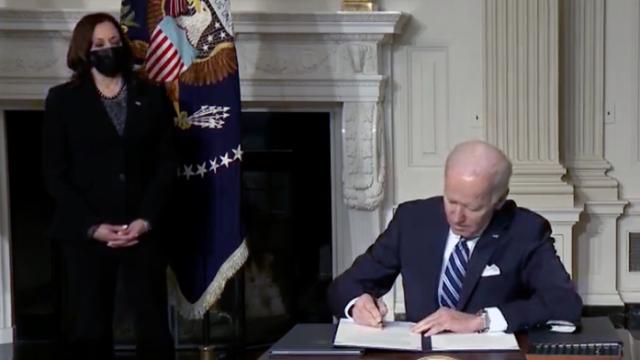
President Joe Biden signs one of three executive orders on Jan. 27. At left is Vice President Kamala Harris. (Source: White House)
President Joe Biden’s climate train left the station as promised on Jan. 27, powered by the latest batch of executive orders. But is it on the right track? Many in the oil and gas industry say no.
“We share President Biden’s goal for addressing climate change,” API President and CEO Mike Sommers said on a morning call with journalists. “Unfortunately, today’s executive order halting leasing is a step backwards for environmental progress and is nothing more than an ‘import more oil’ policy. That will weaken U.S. energy leadership, hamper the economic recovery and undermine national security.”
One of the orders directed the Department of the Interior to pause new oil and natural gas leasing on public lands and offshore waters while awaiting a comprehensive review of the federal oil and gas program. The department stressed in a statement that existing operations and permits for existing leases will not be affected, nor will it restrict operations on private or state lands.
However, where it does hit, the order has the potential to hit hard.
“Some states, including Wyoming and New Mexico, where the U.S. government owns significant prospective acreage, will be deeply affected,” Kip Hunter, a partner/shareholder at the Hall Estill law firm, said in an email to Hart Energy. “And that impact will, of course, translate directly into a material diminution of related tax revenue which some estimate exceeded $6 billion in the past fiscal year.”
During the signing ceremony, Biden reiterated that his administration is not going to ban fracking even as he asserted that climate change would be the center of his national security and foreign policy.
“In my view, we’ve already waited too long to deal with the climate crisis,” he said.
Creating or Killing?
Biden’s plan to tackle climate change includes creation of jobs in the construction, manufacturing, engineering and skilled trades to support clean energy infrastructure. It calls for the establishment of a Climate Conservation Corps to put people to work in the conserving public lands and waters, increasing reforestation and increasing carbon sequestration in the agriculture sector.
Jennifer Granholm, nominee for Energy Secretary, acknowledged that citizens in energy communities were at risk in the energy transition during her hearing before the Senate Energy and Natural Resources Committee on Jan. 27.
Biden DOE Pick Faces Senate Confirmation Hearing
“We have to make sure that we don’t leave people behind,” said Granholm, former governor of Michigan. “People who have been disproportionately affected by these transitions feel like they’ve been forgotten. That’s not what’s going to happen. The Biden administration has pledged to commit 40% of the benefits of this clean energy transition to communities that have been left behind and communities in transition. We have to commit to getting job providers into these communities and give them hope for the future.”
However, in the short term, oil and gas representatives said, the policies have the potential to cost jobs. An API analysis projected the loss of 1 million jobs by the end of 2022 if a federal leasing and development ban were made permanent. New Mexico alone, where the federal government owns 57% of oil and gas land, could lose as many as 62,000 jobs.
“Our state is dependent on oil and gas,” Ryan Flynn, president of the New Mexico Oil and Gas Association, said during the call. “Nearly one-third of our state’s budget comes directly from oil and gas revenue and of that, approximately $1 billion comes from revenue generated on federal public lands.”
In Wyoming, 50% of the oil and gas area, and 75% of subsurface minerals are owned by the federal government, said Pete Obermueller, president of the Petroleum Association of Wyoming. The industry in that state, he said, consists of 80% “mom and pop” companies particularly vulnerable to disruption.
Even Texas, where there are few oil and gas operations on federal land, would be vulnerable to the loss of about 120,000 jobs along the coast that are directly and indirectly connected to offshore Gulf of Mexico drilling.
Upshot
There was an undercurrent of resentment in many of the statements by industry representatives that climate change policies were targeting an industry that has been a leading force in emission reductions.
“Unfortunately, today’s moratorium isn’t about climate change or helping lower global emissions,” said David Holt, president of the Consumer Energy Alliance. “The fact remains that the U.S. for two decades has led the world in environmental improvement by delivering the largest absolute emissions reductions year after year, even while becoming one of the largest producers of oil and gas. We have demonstrated to the rest of the globe the resolve, discipline and ingenuity required to meet environmental goals, economic needs and energy requirements simultaneously.”
Erik Milito, president of the National Ocean Industries Association (NOIA), echoed that sentiment, declaring in a statement that “there is no shortage of negative consequences from this leasing pause.”
The carbon intensity of the Gulf of Mexico is half that of other producing regions with deepwater production, he said. “While the executive order is framed as a step towards a climate solution, it pauses energy opportunities in a region that is already addressing climate and emissions goals.”
If, as suspected by Sommers of API, the executive orders were only the first step in banning drilling permits on public lands and waters, litigation would likely follow, said Stacey Morris, director of research for Alerian, in an email to Hart Energy. In the meantime, E&Ps have been stocking up on permits ahead of the start of the Biden administration, and operators would probably move to private lands if activity on federal lands is curbed, she said.
“Ultimately, if new or more severe regulations negatively impact U.S. energy production, it could be beneficial for oil and natural gas prices—a potential silver lining for the industry but possibly negative for consumers,” Morris said. “With oil prices [and to a lesser extent, natural gas prices] tending to drive sentiment and stock prices for the energy sector, regulations that appear negative for the industry on the surface could be offset by some derivative positive impacts to oil and natural gas prices.”
Recommended Reading
Some Payne, But Mostly Gain for H&P in Q4 2023
2024-01-31 - Helmerich & Payne’s revenue grew internationally and in North America but declined in the Gulf of Mexico compared to the previous quarter.
Kimmeridge Fast Forwards on SilverBow with Takeover Bid
2024-03-13 - Investment firm Kimmeridge Energy Management, which first asked for additional SilverBow Resources board seats, has followed up with a buyout offer. A deal would make a nearly 1 Bcfe/d Eagle Ford pureplay.
M4E Lithium Closes Funding for Brazilian Lithium Exploration
2024-03-15 - M4E’s financing package includes an equity investment, a royalty purchase and an option for a strategic offtake agreement.
Laredo Oil Subsidiary, Erehwon Enter Into Drilling Agreement with Texakoma
2024-03-14 - The agreement with Lustre Oil and Erehwon Oil & Gas would allow Texakoma to participate in the development of 7,375 net acres of mineral rights in Valley County, Montana.
California Resources Corp. Nominates Christian Kendall to Board of Directors
2024-03-21 - California Resources Corp. has nominated Christian Kendall, former president and CEO of Denbury, to serve on its board.






